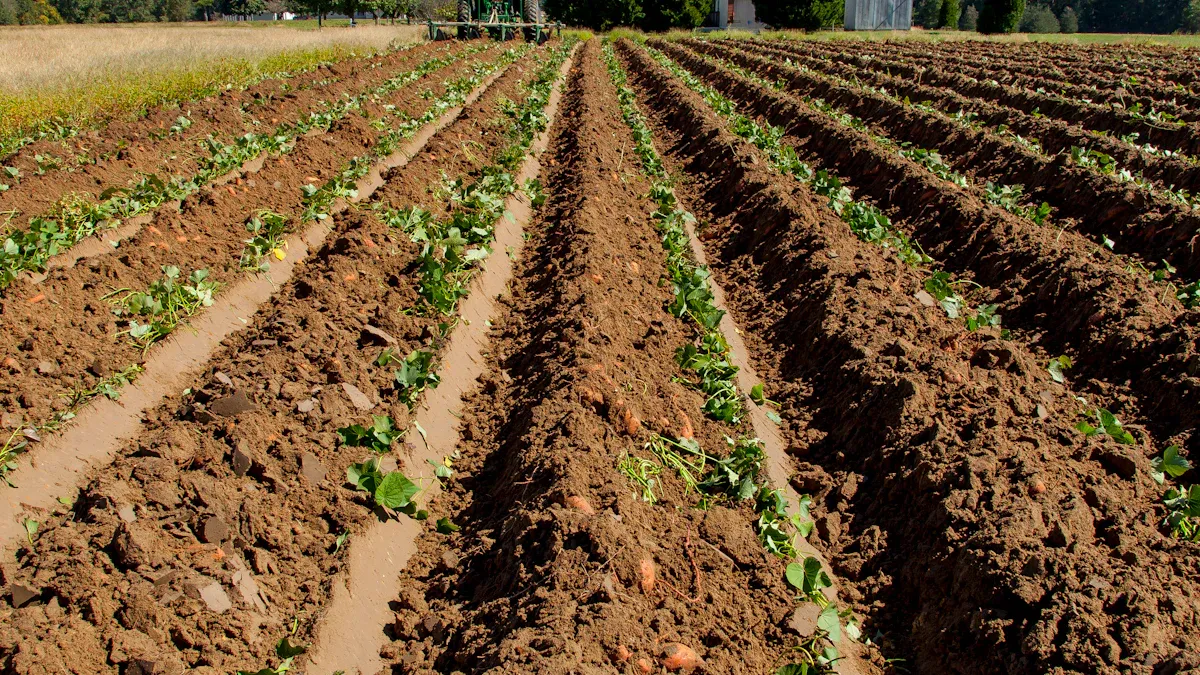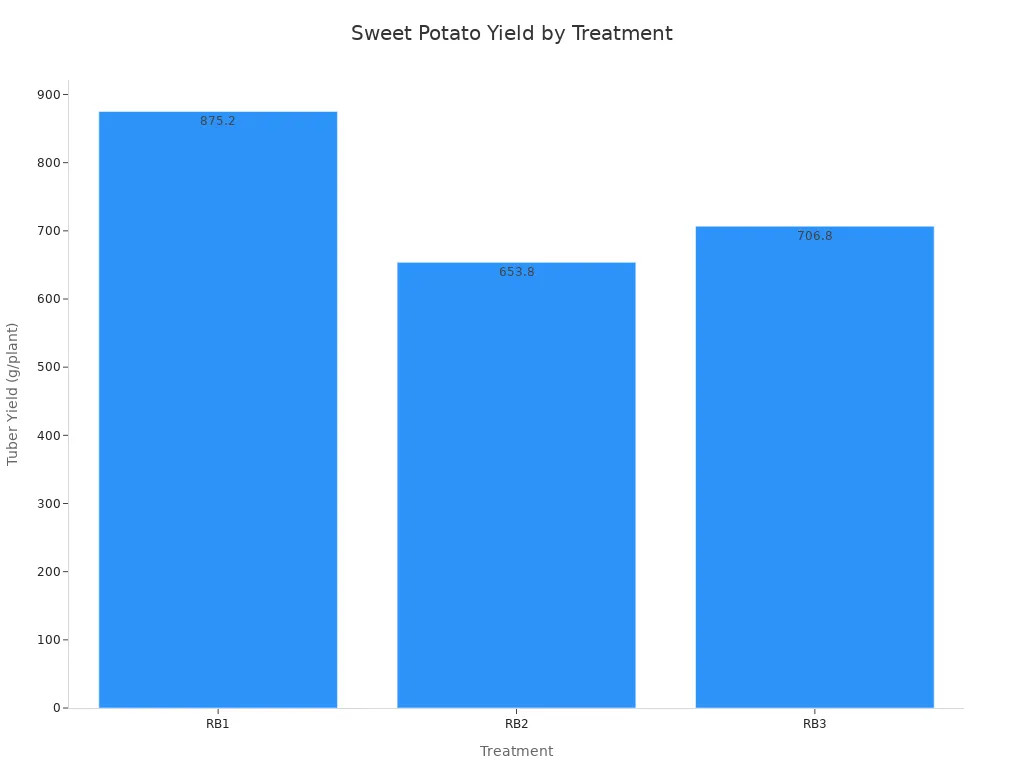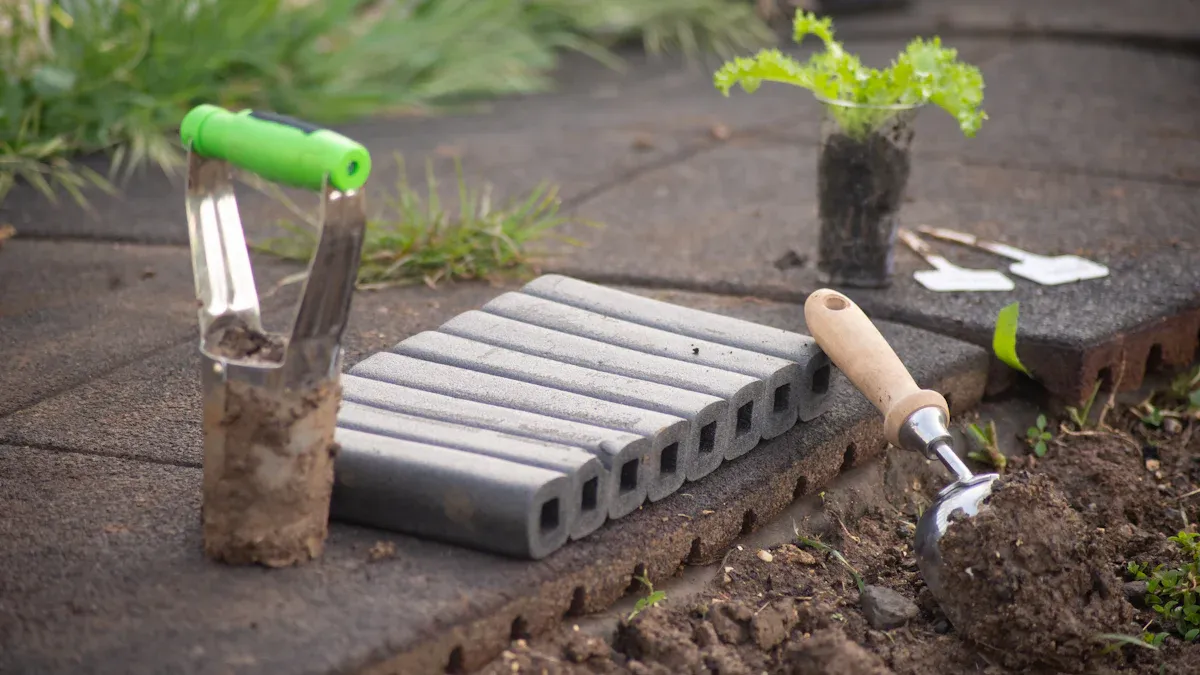
When you plant sweet potato plants, aim for a depth of 8 to 12 inches. This depth supports optimal tuber development. For sweet potato slips, you should place them 3 to 4 inches deep in the soil. Following these guidelines helps ensure a healthy and productive harvest.
Key Takeaways
Plant sweet potato slips at a depth of 3 to 4 inches for optimal root development.
Aim for a planting depth of 8 to 12 inches to maximize tuber size and quality.
Consider soil type and climate conditions to enhance your sweet potato harvest.
Importance of Planting Depth

When you plant sweet potato plants, the depth at which you place them significantly influences their growth and the quality of the tubers. Understanding this relationship can help you achieve a more fruitful harvest.
Impact on Tuber Development
The depth of planting directly affects the size and quality of sweet potato tubers. Research shows that a planting depth of around 7 inches yields the highest specific gravity in the tubers. This measure indicates better quality due to increased dry matter content. In contrast, shallower planting depths of 3 and 5 inches lead to lower specific gravity, suggesting reduced quality for processing.
Key Points:
Deeper planting supports larger tuber growth.
Optimal depth enhances the nutritional quality of the tubers.
Shallow planting can hinder tuber development.
Effects on Overall Growth
The overall growth of sweet potato plants also hinges on planting depth. Studies demonstrate a clear relationship between planting depth and yield. The following table summarizes the findings from various treatments:
Treatment | Tuber Yield (g/plant) | Yield Increase (%) |
|---|---|---|
RB1 | 875.2 | 23.8 – 33.8 |
RB2 | 653.8 | N/A |
RB3 | 706.8 | N/A |

From this data, you can see that deeper planting generally results in higher yields. By planting sweet potato plants at the recommended depth of 8 to 12 inches, you can maximize your harvest potential.
Factors to Consider When You Plant Sweet Potato Plants
Soil Type
Soil type plays a crucial role in determining how deep you should plant sweet potato plants. Different soil textures can affect drainage and root development. Here are some key points to consider:
Sandy Soil: This type drains quickly. You should plant sweet potatoes on ridges that are 8 to 14 inches high to enhance drainage.
Loamy Soil: Ideal for sweet potatoes, loamy soil retains moisture while allowing for good drainage. Planting at a depth of 8 to 12 inches works well here.
Clay Soil: This soil retains water, which can lead to rot. Planting on raised ridges helps improve drainage and prevents waterlogging.
Preparing the soil 2 to 3 months before planting helps decompose debris and minimizes diseases.
Climate Conditions
Climate conditions also influence your planting decisions. Sweet potatoes thrive in warm weather. Here are some requirements to keep in mind:
Condition | Requirement |
|---|---|
Soil Temperature | At least 65°F (18°C) |
Nighttime Temperature | At least 55°F (13°C) |
Last Spring Frost | 3 to 4 weeks after last frost |
Ensure that you plant sweet potatoes after the danger of frost has passed. This timing allows the soil to warm up, promoting healthy growth.
Plant Variety
Different sweet potato varieties may require adjustments in planting depth. Some varieties grow larger tubers and need more space. Here are some tips:
Spacing: Maintain a distance of 12 to 18 inches between plants.
Ridge Height: Plant on a wide, raised ridge about 8 inches high to improve drainage and warmth.
By considering these factors, you can optimize your planting strategy and enhance your sweet potato harvest.
Step-by-Step Guide to Plant Sweet Potato Plants

Preparing the Soil
Before you plant sweet potato plants, you must prepare the soil properly. Sweet potatoes thrive in well-draining, fertile soil. Follow these steps to get your soil ready:
Choose a Sunny Location: Sweet potatoes need full sun for at least six hours a day.
Mix Soil Components: Combine two-thirds potting mix with one-third organic matter, such as compost or aged manure. This mix provides nutrients and improves soil structure.
Loosen the Soil: Use a broadfork or garden fork to aerate the soil to a depth of at least 6 inches. This step helps roots grow freely.
Add Compost: Spread 1 to 4 inches of compost on the garden bed and mix it into the top layer of soil. This addition enhances fertility and drainage.
Planting Technique
Once your soil is prepared, it’s time to plant sweet potato slips. Use the following techniques to maximize tuber development:
Technique | Description |
|---|---|
Slip Size | Use slips that are 10 to 12 inches long. This size increases the number of nodes and energy source. |
Soil Moisture | Keep the soil evenly moist. Avoid wet or dry conditions to support healthy root development. |
Soil and Air Temperatures | Aim for optimal temperatures of 85-89°F during the day and lower 70s at night for transplanting. |
Nitrogen | Apply 30 to 40 pounds of nitrogen per acre. This amount supports optimal root development. |
Planting Depth | Plant slips at least 5 inches deep to create a stable environment for roots and maximize yield. |
When planting, space your slips 12 to 18 inches apart. This spacing allows each plant enough room to grow without competing for nutrients.
Watering and Care
After planting, proper watering and care are essential for healthy growth. Follow these guidelines:
Initial Watering: Water every 2-3 days during the first three weeks to help establish the plants.
Adjust Watering Schedule: Water twice a week during weeks 4-8, when the vines develop. Reduce to once a week during weeks 9-12, as tubers form.
Monitor Soil Moisture: Use the finger test—stick your finger 2 inches into the soil. If it feels dry, it’s time to water.
Deep Watering: Aim for 1 to 1.5 inches of water per week, including rainfall. Deep, infrequent watering encourages strong root growth.
Mulching: Apply organic mulch around the plants. Mulch retains moisture, suppresses weeds, and improves soil health.
By following these steps, you can ensure that your sweet potato plants receive the care they need for a successful harvest.
Common Mistakes When You Plant Sweet Potato Plants
Planting Too Deep
Planting sweet potato slips too deep can lead to several issues. When you bury the slips more than 5 inches, you risk burying essential nodes. This mistake can hinder tuber formation and reduce plant survival rates. Proper depth is crucial for root development. If you bury at least two nodes below the soil line, you can optimize yield.
Tip: Always check the depth before covering the slips with soil.
Planting Too Shallow
On the other hand, planting too shallow can also cause problems. If you place the slips less than 3 inches deep, they may not establish strong roots. Shallow planting can lead to wilting and drooping slips, resulting in stunted growth.
Common Error | Consequence |
|---|---|
Not keeping slips evenly moist | Slips may wilt and droop, leading to stunted growth. |
Transplanting frail slips | Results in poor rooting and overall plant health. |
Ignoring Spacing Guidelines
Spacing is another critical factor. If you ignore spacing guidelines and plant slips too close together, they will compete for nutrients and sunlight. This competition can lead to smaller tubers and lower yields. Aim for a distance of 12 to 18 inches between each slip to ensure healthy growth.
Remember: Proper spacing allows each plant to thrive without competition.
By avoiding these common mistakes, you can enhance your chances of a successful sweet potato harvest.
To achieve a successful sweet potato harvest, plant slips at a depth of 3 to 4 inches. Proper planting depth ensures root penetration and optimal tuber shape. Following these guidelines can lead to increased yields and improved economic sustainability. Consider all factors discussed for the best results! 🌱
FAQ
How long does it take for sweet potatoes to grow?
Sweet potatoes typically take 90 to 120 days to mature after planting, depending on the variety and growing conditions. 🌱
Can I grow sweet potatoes in containers?
Yes, you can grow sweet potatoes in large containers. Ensure they have good drainage and enough space for root development. 🪴
What pests should I watch for when growing sweet potatoes?
Watch for pests like sweet potato weevils and aphids. Regularly inspect your plants and take action if you notice any signs of infestation. ⚠️
